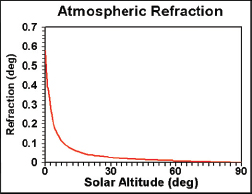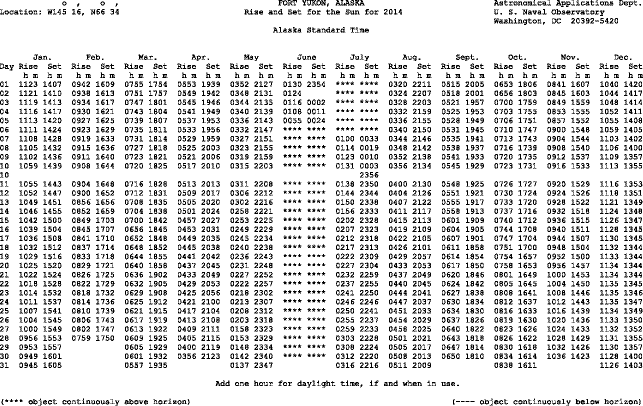Atmospheric Refraction
Objectives:
Light does not always travel in straight lines (even though our minds always assume that the light entering our eyes did just that)! Air may be transparent, but it slightly slows the speed of light passing through it as compared to light’s speed in a vacuum. The greater the number of air molecules encountered, the more the light is slowed. When the Sun is close to the horizon, particularly near sunrise or sunset, the Sun’s rays entering the atmosphere at a low angle must travel through a relatively long air path. Light rays approaching Earth’s surface are progressively slowed as they pass through the higher altitude, less dense air into lower altitude, more dense air. Associated with the slowing is a downward “bending” (refraction) of the light ray. You have observed the effects of this if you have viewed sunsets or sunrises.
After completing this investigation, you should be able to:
- Describe how refraction of light varies with solar altitude.
- Explain how solar refraction affects length of daylight.
Introduction:
You can observe the refraction of light passing from a less dense medium into a more dense medium using an opaque cup, a coin, and water. Place the coin at the bottom of the empty cup and look into the cup at an angle such that you cannot quite see the coin over the edge of the cup (Figure 1a). Slowly pour water into the cup, making sure the coin remains in the same position. The coin in the water should appear “magically,” as shown in Figure 1b. Reflected light from the coin is refracted when it passes from water to air as shown by the solid-line path.

Figure 1. (a) Light ray without refraction and (b) with refraction at a density interface.
The total path of air through which a light ray from the Sun must pass to an observer varies with the observer’s latitude and the time of day. For someone on the equator at local noon on an equinox, the Sun is directly overhead at the zenith and its solar altitude is 90 degrees. The rays of the Sun come straight down and pass through the minimum atmospheric path length. At sunrise or sunset (solar altitude of 0 degrees), the atmospheric path is maximum in length. The amount of refraction or bending of light rays from the Sun due to atmospheric effects can be calculated for the Sun’s solar altitude angle. Figure 2 shows the amount of refraction that occurs (in degrees) for a clear sky at various solar altitudes.
1. Figure 2 shows that the atmospheric refraction of light [(increases)(decreases)] as the solar altitude decreases (approaches the horizon).
2. The maximum amount of atmospheric refraction of a solar ray is [(less than one degree)(several degrees)] when the Sun is on the horizon (solar altitude of 0 degrees).

Figure 2. Amount of angular refraction of sunlight as a function of solar altitude.
3. At sunset (or sunrise) with the Sun right on the horizon, the refraction of a Sun’s ray is 0.58 degrees. The mean angular diameter of the Sun’s visible disk is approximately 0.53 degrees. (Angular diameter is the angle formed at the observer’s eye by two lines drawn from opposite edges of the Sun’s disk.) Thus, the Sun’s position may be distorted by the bending of its rays by slightly more than its own diameter. When very near the horizon, the apparent Sun (the one we see) is approximately [(0.5)(3)] degree(s) higher than it would be in the absence of atmospheric refraction. In other words, the Sun can actually be below the horizon when the bent rays give its appearance as being fully above the horizon!
4. Refer to Figure 3 of Investigation 3B. A spherical Earth would be half sunlit at all latitudes on an equinox, except at the poles. Without an atmosphere, the period of daylight at any latitude on Earth (except at the poles) would be [(11)(12)(13)] hours and 0 minutes on that first day of spring or fall.
5. Sunrise or sunset occurs when the upper limb (edge) of the Sun’s visible disk is first or last seen under average atmospheric conditions, on a water horizon.
As shown in Figure 6 of Investigation 3B, the daily path of the Sun through the sky varies at different latitudes on Earth. At the equator, the daily path of the Sun is always perpendicular to the horizon. As the latitude increases, the angle between the Sun’s path through the daytime sky and the horizon [(increases)(decreases)] until it is nearly parallel to the local horizon at the North and South Poles. Thus, the time it takes the Sun to change solar altitude (measured vertically from the horizon) while actually moving steadily along its inclined path will increase with increasing latitude.
In Table 1, sunrise and sunset times are given for Quito, Ecuador (0.02 degrees N, 78.5 degrees W), Gettysburg, South Dakota (45.0 degrees N, 100.0 degrees W), and Thule Airbase, Greenland (76.5 degrees N, 68.8 degrees W) for 21 March (representative of the first day of spring). For each city calculate the total length of daylight for 21 March and the minutes beyond 12 hours due to atmospheric refraction. [Table values were obtained from the U.S. Naval Observatory website: http://aa.usno.navy.mil/data/docs/RS_OneDay.php ().]
Table 1: Sunrise/Sunset Times - 21 March
|
City |
Latitude |
Sunrise |
Sunset |
|
Quito |
0.0° N |
6:16 a.m. |
6:22 p.m. |
|
Gettysburg |
45.0° N |
6:41 |
6:54 |
|
Thule |
76.5° N |
4:55 |
5:33 |
Note: due to the city’s location within its time zone and other astronomical factors, the daylight period is not symmetrical about noon.
6. Quito’s hours and minutes of daylight: 12 hrs [(0)(6)(13)(38)(46)] min.
7. Gettysburg’s hours and minutes of daylight: 12 hrs [(0)(6)(13)(38)(46)] min.
8. Thule’s hours and minutes of daylight: 12 hrs [(0)(6)(13)(38)(46)] min.
9. Quito ‘s minutes of daylight beyond 12 hours: [(0)(6)(13)(38)(46)] min.
10. Gettysburg’s minutes of daylight beyond 12 hours: [(0)(6)(13)(38)(46)] min.
11. Thule’s minutes of daylight beyond 12 hours: [(0)(6)(13)(38)(46)] min.
12. The number of minutes of daylight beyond twelve hours on 21 March [(increases)(decreases)] with increasing latitude. The additional daylight time is due to the combination of two factors, the orientation of the Sun’s path and atmospheric refraction. The smaller the angle of the Sun’s path to the horizon, the greater the effect of refraction in lengthening the period of daylight.
As directed by your course instructor, complete this investigation by either:
- Going to the Current Weather Studies link on the course website, or
- Continuing the Applications section for this investigation that immediately follows.
Investigation 14B: Applications
13. The sunrise/sunset data appearing in Table 1 were taken from tables similar to the example shown in Table 2 of this investigation. Table 2 displays “Rise and Set for the Sun for 2014” for Fort Yukon, Alaska, located at 66.6 degrees N. The sunrise and sunset times are given in local Standard Time on a 24-hour clock; for example, 1842 means 6:42 p.m., local Standard Time. The table indicates that on 20 March 2014 (date of the 2014 spring equinox) the Sun rose at 06:40 and set at [(17:57)(18:58)(19:19)(19:38)], local Standard Time.
14. Fort Yukon’s period of sunlight on 20 March was 12 hours and [(0)(8)(18)(28)] minutes.
15. The number of minutes of daylight beyond 12 hours on 20 March at Fort Yukon [(fits)(does not fit)] the pattern of change in the length of daylight with increasing latitude shown in Table 1. [The one day difference in the dates of Table 1 and 2 data can be ignored in the comparison.]
Fort Yukon, at 66.6 degrees N, is located almost exactly on the Arctic Circle (66.5 degrees N). From astronomical considerations based on straight and parallel rays of sunlight striking a spherical Earth, the Arctic Circle (or the Antarctic Circle) should be the lowest latitude at which there would be one continuous 24-hour period of daylight and one continuous 24-hour period of darkness each year.
16. However, according to Table 2, the longest continuous daylight period (****) at Fort Yukon was [(1)(7)(16)(31)(42)] days in length.
17. According to the table, the shortest period of daylight at Fort Yukon occurs on or near the first day of winter in late December and is two hours and [(0)(7)(10)(21)] minutes long.
18. Atmospheric refraction is the primary cause of the differences between the periods of daylight that might be expected with straight rays of sunlight striking the Earth’s surface and the daylight periods calculated by the U.S. Naval Observatory. It was shown earlier in this investigation that, when near the horizon, the apparent Sun (the one we see) is [(higher)(lower)] than it would be if there were no atmospheric refraction. Thus, over the period of a year the Sun at the Arctic Circle stays continuously above the horizon for considerably more than one day and it never actually goes below the horizon for a continuous 24-hour day.
Suggestions for further activities: The U.S. Naval Observatory provides sunrise and sunset tables for over 22,000 locations in the United States. Go to the following Internet address:
http://aa.usno.navy.mil/data/docs/RS_OneYear.php ().
On this Naval Oceanography Portal website, call up the current year’s “sunrise/sunset” table for your hometown by specifying the requested information. Scroll down to “U.S. Cities or Towns”. Then click “Compute Table”. A table should appear. If the message: “Unable to find location in our file. Try another location.” is returned, check your spelling or select a nearby larger community.
Print out the table. To print the full 12-month table (you may wish to keep it with your study materials for possible future reference), you must use landscape orientation and 8-point type. Your Internet browser contains options (often called “preferences”) that allow you to select the font style and size to use for text files such as this (“fixed font”). If you cannot vary these options yourself, contact your instructor or computer resource person. [Note: Be sure to change your font, size, and orientation back to your original settings after printing out the table.]

Table 2. Daily sunrise and sunset times for Fort Yukon, Alaska (66 degrees, 34 minutes N).